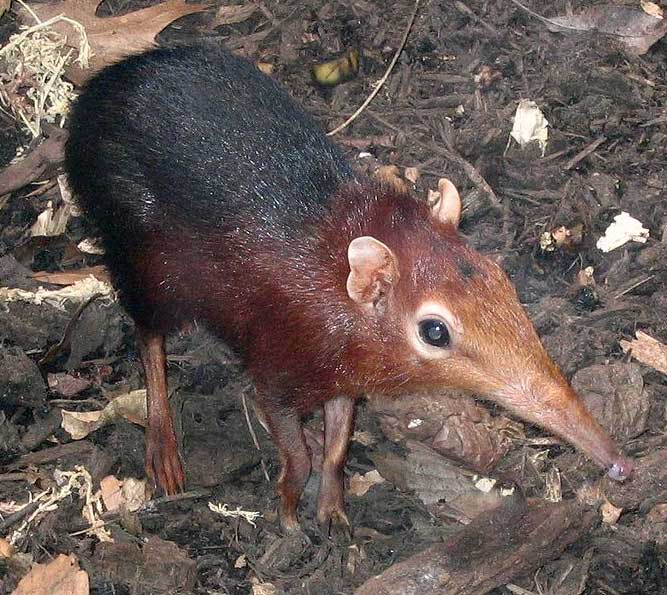
Rhynchocyon petersi (*)
Superregnum: Eukaryota
Cladus: Unikonta
Cladus: Opisthokonta
Cladus: Holozoa
Regnum: Animalia
Subregnum: Eumetazoa
Cladus: Bilateria
Cladus: Nephrozoa
Superphylum: Deuterostomia
Phylum: Chordata
Subphylum: Vertebrata
Infraphylum: Gnathostomata
Megaclassis: Osteichthyes
Cladus: Sarcopterygii
Cladus: Rhipidistia
Cladus: Tetrapodomorpha
Cladus: Eotetrapodiformes
Cladus: Elpistostegalia
Superclassis: Tetrapoda
Cladus: Reptiliomorpha
Cladus: Amniota
Cladus: Synapsida
Cladus: Eupelycosauria
Cladus: Sphenacodontia
Cladus: Sphenacodontoidea
Cladus: Therapsida
Cladus: Theriodontia
Cladus: Cynodontia
Cladus: Eucynodontia
Cladus: Probainognathia
Cladus: Prozostrodontia
Cladus: Mammaliaformes
Classis: Mammalia
Subclassis: Trechnotheria
Infraclassis: Zatheria
Supercohors: Theria
Cohors: Eutheria
Magnordo: Epitheria
Superordo: Afrotheria
Cladus: Afroinsectiphilia
Ordo: Macroscelidea
Familia: Macroscelididae
Subfamilia: Rhynchocyoninae
Genus: Rhynchocyon
Species:Rhynchocyon petersi
Name
Rhynchocyon petersi (Bocage, 1880)
References
Rhynchocyon petersi in Mammal Species of the World.
Wilson, Don E. & Reeder, DeeAnn M. (Editors) 2005. Mammal Species of the World – A Taxonomic and Geographic Reference. Third edition. ISBN 0-8018-8221-4.
Vernacular names
Ελληνικά: Μελανερυθροκίτρινη Ελεφαντομέγαιρα
English: Black and Rufous Elephant Shrew
español: Musaraña elefante de Peters
The black and rufous elephant shrew[2] (Rhynchocyon petersi), the black and rufous sengi,[1] or the Zanj elephant shrew[3] is one of the 17 species of elephant shrew found only in Africa.[2] It is native to the lowland montane and dense forests of Kenya and Tanzania.[4] Like other members of the genus Rhynchocyon, it is a relatively large species, with adults averaging about 28 cm (11 in) in length and 450–700 g (16–25 oz) in weight.
Distribution and habitat
Distribution of Rhynchocyon petersi in the Tanzanian Eastern Arc Mountains. The species is typically limited to small, fragmented forest patches (darker blue) within the mountains (blue).
The forests of the Eastern Arc Mountains are critical habitats for R. petersi.[5] The Chome Forest Reserve in Tanzania is an isolated, and largely undisturbed, habitat for the shrews.[5] Populations densities in the Chome area are significantly lower than the surrounding areas, home to approximately 2700 R. petersi, and is thought to be the result of restricted migration and illegal human activity.[5] It was once listed by the IUCN Red List as vulnerable, but has since been changed to a status of least concern.[1] However, its numbers are reportedly declining; suffering from severe forest fragmentation and degradation from human expansion.[6]
Diet and behaviour
Black and rufous elephant shrew foraging
It eats insects such as beetles, termites, and centipedes, using its proboscis to dig them from the soil and its tongue to lick them up.[7] Like most elephant shrews, it lives in monogamous pairs, defending hectare-sized territories.[8][9] It typically builds ground level nests for shelter[9] requiring dry leaf litter[3] often at the base of trees.[5]
Elephant shrews in zoological gardens
Several zoos have begun breeding this elephant shrew, including seven in Europe,[10] such as the Prague and Wrocław zoos, as well as zoos in the United States like the Philadelphia Zoo. Two black and rufous elephant shrew males were born on February 4, 2007, at the National Zoo in Washington, D.C.
References
Hoffmann, M.; Burgess, N.; Rovero, F. (2016). "Rhynchocyon petersi". IUCN Red List of Threatened Species. 2016: e.T19708A21286959. doi:10.2305/IUCN.UK.2016-1.RLTS.T19708A21286959.en. Retrieved 18 November 2021.
Schlitter, D.A. (2005). "Order Macroscelidea". In Wilson, D.E.; Reeder, D.M (eds.). Mammal Species of the World: A Taxonomic and Geographic Reference (3rd ed.). Johns Hopkins University Press. p. 85. ISBN 978-0-8018-8221-0. OCLC 62265494.
Norbert J. Cordeiro; Nathalie Seddon; David R. Capper; Jonathan M. M. Ekstrom; Kim M. Howell; Isabel S. Isherwood; Charles A. M. Msuya; Jonas T. Mushi; Andrew W. Perkin; Robert G. Pople & William T. Stanley (2005), "Notes on the ecology and status of some forest mammals in four Eastern Arc Mountains", Journal of East African Natural History, 94 (1): 175–189, doi:10.2982/0012-8317(2005)94[175:noteas]2.0.co;2, S2CID 85816994
G. Rathbun. (1984). Elephant-shrews, Order Macroscelidea. In : MacDonald (ed), The Encyclopedia of Mammals. Facts on File Publications, New York: 730–735.
Stephanie Coster & David O. Ribble (2005), "Density and cover preferences of Black-and-rufous elephant-shrews (Rhynchocyon petersi) in Chome Forest Reserve, Tanzania", Belgian Journal of Zoology, 135: 175–177
M. Hoffmann, N. Burgess, and F. Rovero. (2016). Rhynchocyon petersi. The IUCN Red List of Threatened Species 2016: e.T19708A21286959. https://dx.doi.org/10.2305/IUCN.UK.2016- 1.RLTS.T19708A21286959.en
J. Kingdon (1997), The Kingdon Field Guide to African Mammals, Academic Press, pp. 142–152
C. D. Fitzgibbon & G. B. Rathbun (1994), "Surveying Rhynchocyon elephant-shrews in tropical forest", African Journal of Ecology, 32: 50–57, doi:10.1111/j.1365-2028.1994.tb00554.x
G. B. Rathbun (1979), "The social structure and ecology of elephant-shrews", Journal of Comparative Ethology, 20: 1–77
https://www.prazskyden.cz/prazska-zoo-ma-noveho-vzacneho-obyvatele-zije-jen-v-nekolika-evropskych-zahradach/ Prague ZOO exhibits new elephant shrews
Retrieved from "http://en.wikipedia.org/"
All text is available under the terms of the GNU Free Documentation License

